fog light Citroen C4 PICASSO 2016 2.G Owner's Manual
[x] Cancel search | Manufacturer: CITROEN, Model Year: 2016, Model line: C4 PICASSO, Model: Citroen C4 PICASSO 2016 2.GPages: 527, PDF Size: 13.72 MB
Page 11 of 527
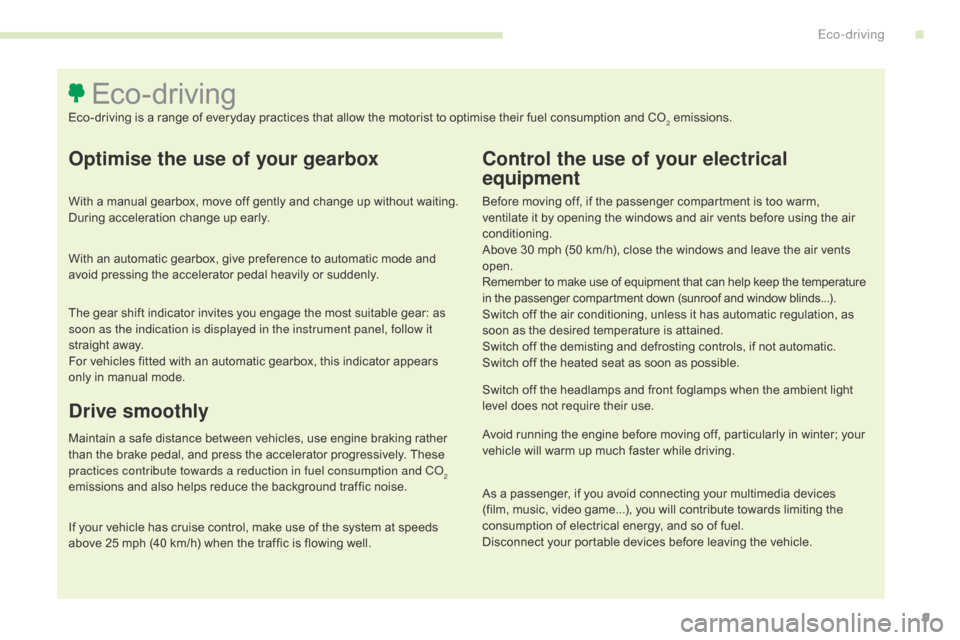
9
C4-Picasso-II_en_Chap00c_eco-conduite_ed01-2016
Optimise the use of your gearbox
With a manual gearbox, move off gently and change up without waiting. During acceleration change up early.
With
an automatic gearbox, give preference to automatic mode and
a
void pressing the accelerator pedal heavily or suddenly.
Control the use of your electrical
equipment
Before moving off, if the passenger compartment is too warm, ventilate it by opening the windows and air vents before using the air
c
onditioning.
Above
30 mph (50 km/h), close the windows and leave the air vents
ope
n.
Remember
to make use of equipment that can help keep the temperature
i
n the passenger compartment down (sunroof and window blinds...).
Switch
off the air conditioning, unless it has automatic regulation, as
s
oon as the desired temperature is attained.
Switch
off the demisting and defrosting controls, if not automatic.
Switch
off the heated seat as soon as possible.
Switch
off the headlamps and front foglamps when the ambient light
l
evel does not require their use.
Avoid
running the engine before moving off, particularly in winter; your
v
ehicle will warm up much faster while driving.
As
a passenger, if you avoid connecting your multimedia devices
(
film, music, video game...), you will contribute towards limiting the
c
onsumption of electrical energy, and so of fuel.
Disconnect
your portable devices before leaving the vehicle.
Eco-driving
Eco-driving is a range of everyday practices that allow the motorist to optimise their fuel consumption and CO2 emissions.
Drive smoothly
Maintain a safe distance between vehicles, use engine braking rather than the brake pedal, and press the accelerator progressively. These
p
ractices contribute towards a reduction in fuel consumption and CO
2
emissions
and
also
helps
reduce
the
background
traffic
noise.
If
your
vehicle
has
cruise
control,
make
use
of
the
system
at
speeds
a
bove
25
mph
(40
km/h)
when
the
traffic
is
flowing
well.
The
gear
shift
indicator
invites
you
engage
the
most
suitable
gear:
as
s
oon as the indication is displayed in the instrument panel, follow it
straight
away.
For
vehicles
fitted
with
an
automatic
gearbox,
this
indicator
appears
o
nly
in
manual
mode.
.
Eco-driving
Page 25 of 527
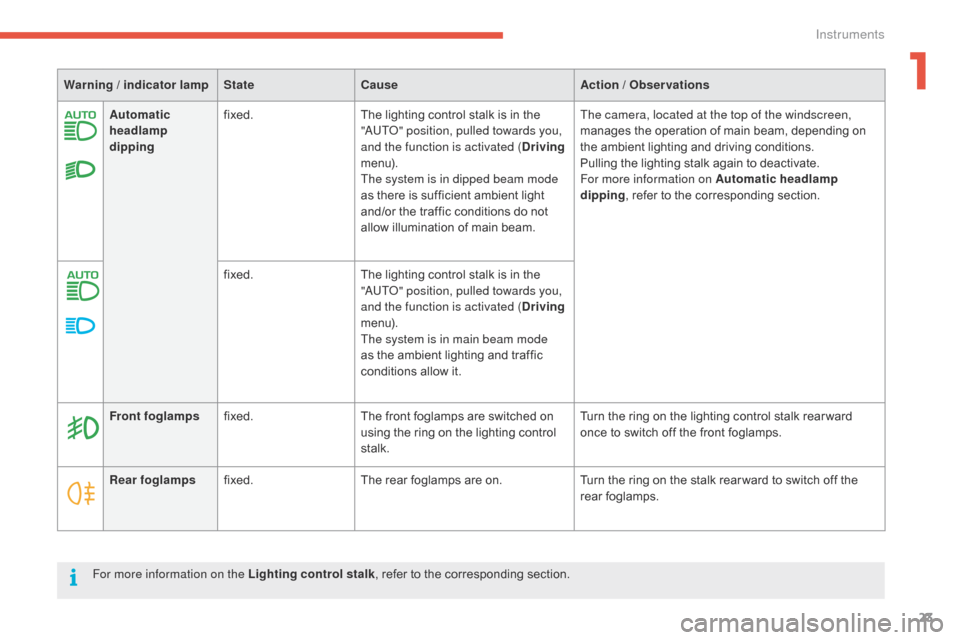
23
C4-Picasso-II_en_Chap01_instruments-bord_ed01-2016
Automatic
headlamp
dippingfixed.
The lighting control stalk is in the "
AUTO" position, pulled towards you,
and the function is activated ( Driving
m e n u).
The system is in dipped beam mode
as
there is sufficient ambient light
a
nd/or the traffic conditions do not
a
llow illumination of main beam.The camera, located at the top of the windscreen,
manages
the operation of main beam, depending on
t
he ambient lighting and driving conditions.
Pulling
the lighting stalk again to deactivate.
For more information on Automatic headlamp
dipping ,
refer to the corresponding section.
fixed. The
lighting control stalk is in the
"
AUTO" position, pulled towards you,
and the function is activated ( Driving
m e n u).
The system is in main beam mode
as
the ambient lighting and traffic
c
onditions allow it.
Warning / indicator lamp
StateCause Action / Observations
Rear foglamps fixed. The
rear foglamps are on.Turn
the ring on the stalk rear ward to switch off the
r
ear
fo
glamps.
Front foglamps
fixed. The
front foglamps are switched on
u
sing the ring on the lighting control
st
alk.Turn
the ring on the lighting control stalk rear ward
o
nce to switch off the front foglamps.
For more information on the Lighting control stalk ,
refer to the corresponding section.
1
Instruments
Page 154 of 527
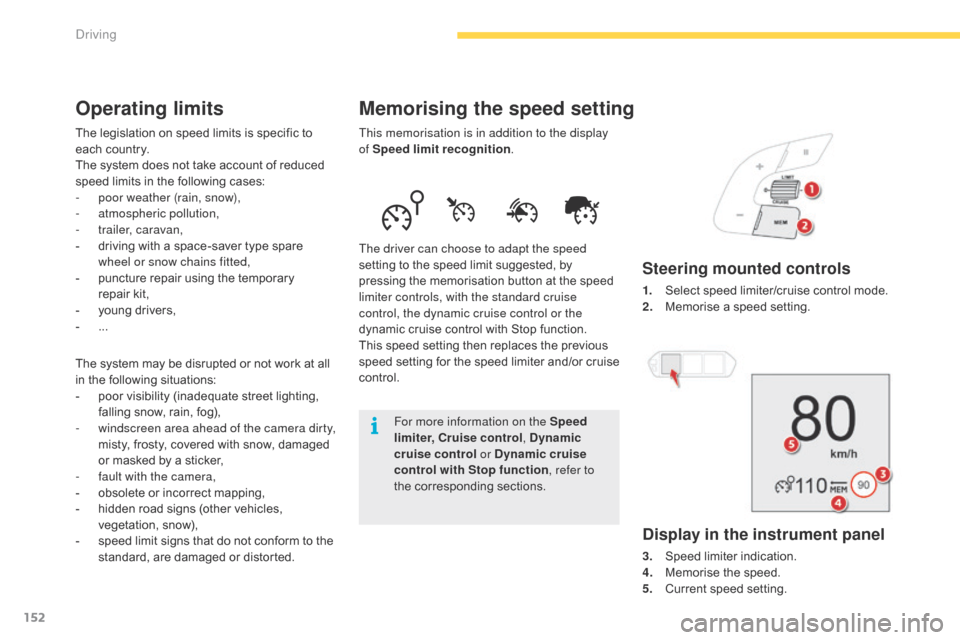
152
C4-Picasso-II_en_Chap04_conduite_ed01-2016
Memorising the speed setting
This memorisation is in addition to the display
of Speed limit recognition .
The driver can choose to adapt the speed
setting
to the speed limit suggested, by
p
ressing the memorisation button at the speed
l
imiter controls, with the standard cruise
control, the dynamic cruise control or the
dynamic
cruise control with Stop function.
This
speed setting then replaces the previous
s
peed
s
etting
f
or
t
he
s
peed
l
imiter
a
nd/or
c
ruise
c
ontrol. For more information on the Speed
limiter, Cruise control , Dynamic
cruise control or Dynamic cruise
control with Stop function , refer to
the
corresponding sections.
Steering mounted controls
1. Select speed limiter/cruise control mode.
2. M emorise a speed setting.
Operating limits
The legislation on speed limits is specific to each country.
The
system does not take account of reduced
s
peed limits in the following cases:
-
p
oor weather (rain, snow),
-
a
tmospheric pollution,
-
t
railer, caravan,
-
d
riving with a space-saver type spare
w
heel or snow chains fitted,
-
p
uncture repair using the temporary
r
epair kit,
-
y
oung
d
rivers,
-
...
T
he system may be disrupted or not work at all
i
n the following situations:
-
p
oor visibility (inadequate street lighting,
f
alling snow, rain, fog),
-
w
indscreen area ahead of the camera dirty,
misty,
frosty, covered with snow, damaged
o
r masked by a sticker,
-
f
ault with the camera,
-
o
bsolete or incorrect mapping,
-
h
idden road signs (other vehicles,
v
egetation,
s
now),
-
s
peed limit signs that do not conform to the
s
tandard, are damaged or distorted.
Display in the instrument panel
3. Speed limiter indication.
4. M emorise the speed.
5.
C
urrent speed setting.
Driving
Page 183 of 527

181
C4-Picasso-II_en_Chap04_conduite_ed01-2016
Limits of operation
The system goes into standby automatically in the following cases:
-
ES
C deactivated or operation
triggered,
-
s
peed below 40 mph (65 km/h) or
a
bove 112 mph (180 km/h),
-
c
onnected electrically to a trailer,
-
u
se of the "space-saver" spare
wheel detected (as detection is
not immediate, deactivation of the
system is recommended),
-
d
ynamic driving style detected,
p
ressure on the brake or
a
ccelerator pedal,
-
d
riving where there are no lane
ma
rkings,
-
ope
ration of the direction indicators,
-
d
riving in a tight corner,
-
i
nactivity by the driver detected
during
c
orrection. The system may not operate correctly
or
at all in the following situations:
-
c
onditions of poor visibility
(inadequate
street lighting,
s
nowfall, rain, fog),
-
d
azzle (headlamps of on oncoming
v
ehicle, low sun, reflections on a
wet
road sur face, leaving a tunnel,
a
lternating light and shade),
-
a
rea of the windscreen in front of
the camera dirty, misted, frosted,
snow-covered,
damaged or
c
overed by a sticker,
-
r
oad markings absent, worn,
h
idden (snow, mud) or multiple
(roadworks),
-
r
unning close to the vehicle in front
(
the lane markings may not be
d
etected),
-
n
arrow, twisty roads.Risk of undesirable operation
Deactivation of the system is recommended in
the following situations:
-
d
riving on a road sur face in poor condition,
-
u
nfavorable weather conditions,
-
d
riving on slippery sur faces (black ice).
The
system is not designed for the following
d
riving
s
ituations:
-
d
riving on a speed circuit,
-
d
riving with a trailer,
-
d
riving on a rolling road,
-
d
riving on unstable sur faces.
In the event of a fault with the system, you are
alerted
by the illumination of these warning
lam
ps in the instrument panel, accompanied by
the
display of a message and an audible signal.
Have
the system checked by a CITROËN
d
ealer or a qualified workshop.
Operating fault
4
Driving
Page 188 of 527

186
C4-Picasso-II_en_Chap04_conduite_ed01-2016
Fatigue detection system
Depending on version, the "Driving time warning system" may be combined with the
"
Fatigue detection system".
Using
a camera placed at the top of the
w
indscreen, the system assesses the driver's
l
evel of vigilance by identifying variations in
t
rajectory compared to the lane markings.
This system is particularly suited to fast roads
(speed
higher than 40 mph (65 km/h)).Once the system considers that the behaviour
of
the vehicle suggests a certain level of fatigue
o
r inattention by the driver, it triggers the first
l
evel of alert.
The
driver is then alerted by the message
"Ta
k e c a r e !", accompanied by an audible
signal.
After
three first level alerts, the system triggers
a
new alert with the message "Take a break! ",
accompanied by a more pronounced audible
signal. In
certain driving conditions (poor road
s
ur face or strong winds), the system
m
ay give alerts independent of the
d
river's level of vigilance.
The following situations may inter fere
w
ith operation of the system or prevent
it working:
-
p
oor visibility (inadequate lighting
o
f the roadway, falling snow, heavy
r
ain, dense fog, ...),
- d azzle (headlamps of an oncoming v
ehicle, low sun, reflections on
a
damp road, leaving a tunnel,
a
lternating shade and light, ...),
-
w
indscreen area located in front
of
the camera: dirty, misted, frost-
covered,
snow-covered, damaged
o
r covered by a sticker,
-
l
ane markings absent, worn,
m
asked (snow, mud) or multiple
(
roadworks,
...
),
-
c
lose to the vehicle ahead (lane
markings
not detected),
-
r
oads that are narrow, winding, ...
Driving
Page 208 of 527
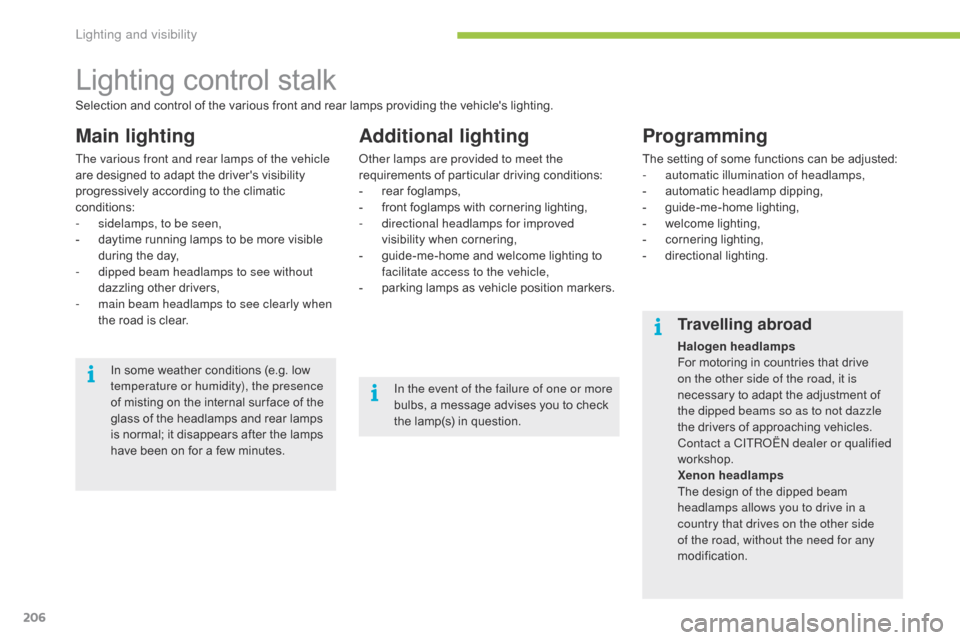
206
C4-Picasso-II_en_Chap05_eclairage-visibilite_ed01-2016
Lighting control stalk
Main lighting
The various front and rear lamps of the vehicle
are designed to adapt the driver's visibility
p
rogressively according to the climatic
c
onditions:
-
s
idelamps, to be seen,
-
d
aytime running lamps to be more visible
d
uring the day,
-
d
ipped beam headlamps to see without
dazzling
o
ther
d
rivers,
-
m
ain beam headlamps to see clearly when
the
road is clear.
Additional lighting
Other lamps are provided to meet the
requirements of particular driving conditions:
-
r
ear
fo
glamps,
-
f
ront foglamps with cornering lighting,
-
d
irectional headlamps for improved
visibility
w
hen
c
ornering,
-
g
uide-me-home and welcome lighting to
f
acilitate access to the vehicle,
-
p
arking lamps as vehicle position markers.
Programming
The setting of some functions can be adjusted:
- a utomatic illumination of headlamps,
-
a
utomatic headlamp dipping,
-
g
uide-me-home lighting,
-
w
elcome lighting,
-
c
ornering lighting,
-
d
irectional
l
ighting.
In
some
weather
conditions
(e.g.
low
t
emperature or humidity), the presence
of
misting
on
the
internal
sur face
of
the
g
lass
of
the
headlamps
and
rear
lamps
i
s
normal;
it
disappears
after
the
lamps
h
ave
been
on
for
a
few
minutes.
Travelling abroad
Halogen headlamps
For motoring in countries that drive
o
n the other side of the road, it is
necessary
to adapt the adjustment of
t
he dipped beams so as to not dazzle
the
drivers of approaching vehicles.
C
ontact a CITROËN dealer or qualified
workshop.
Xenon headlamps
The
design of the dipped beam
h
eadlamps allows you to drive in a
country that drives on the other side
of the road, without the need for any
modification.
In the event of the failure of one or more
bulbs,
a
message
advises
you
to
check
t
he
lamp(s)
in
question.
Selection
and
control
of
the
various
front
and
rear
lamps
providing
the
vehicle's
lighting.
Lighting and visibility
Page 210 of 527
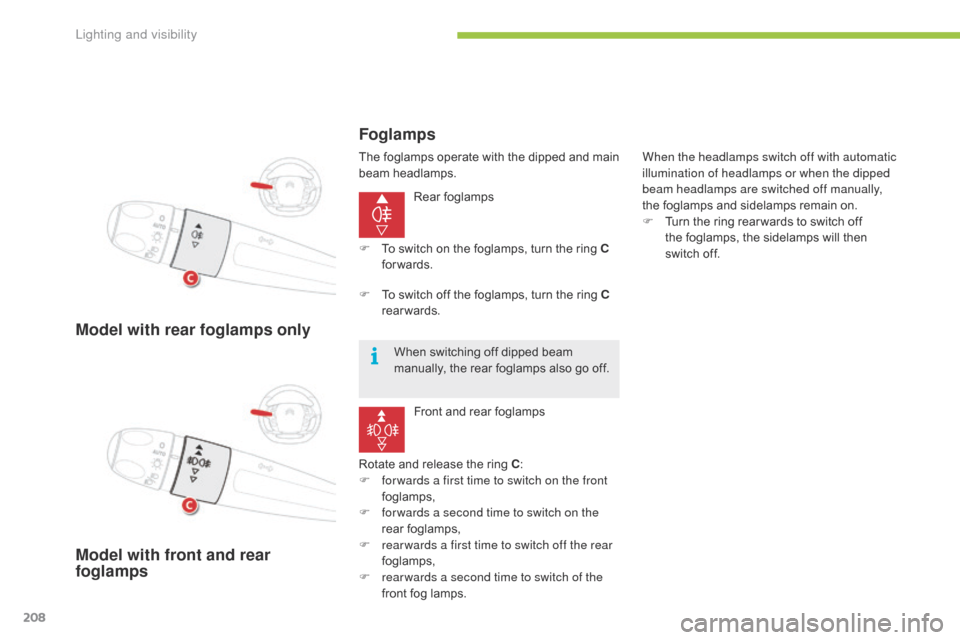
208
C4-Picasso-II_en_Chap05_eclairage-visibilite_ed01-2016
Model with rear foglamps only
Rear foglamps
Rotate
and release the ring C:
F
f
or wards a first time to switch on the front
foglamps,
F
f
or wards a second time to switch on the
rear
fo
glamps,
F
r
ear wards a first time to switch off the rear
foglamps,
F
r
ear wards a second time to switch of the
front
fog lamps.
Model with front and rear
foglamps Foglamps
F To
switch on the foglamps, turn the ring C
forwards.
Front
and rear foglamps
F
T
o switch off the foglamps, turn the ring C
rearwards. When the headlamps switch off with automatic
illumination of headlamps or when the dipped
beam headlamps are switched off manually,
the
foglamps and sidelamps remain on.
F
T
urn the ring rear wards to switch off t
he foglamps, the sidelamps will then s
witch off.
When
switching off dipped beam
m
anually, the rear foglamps also go off.
The
foglamps operate with the dipped and main
b
eam
h
eadlamps.
Lighting and visibility
Page 211 of 527
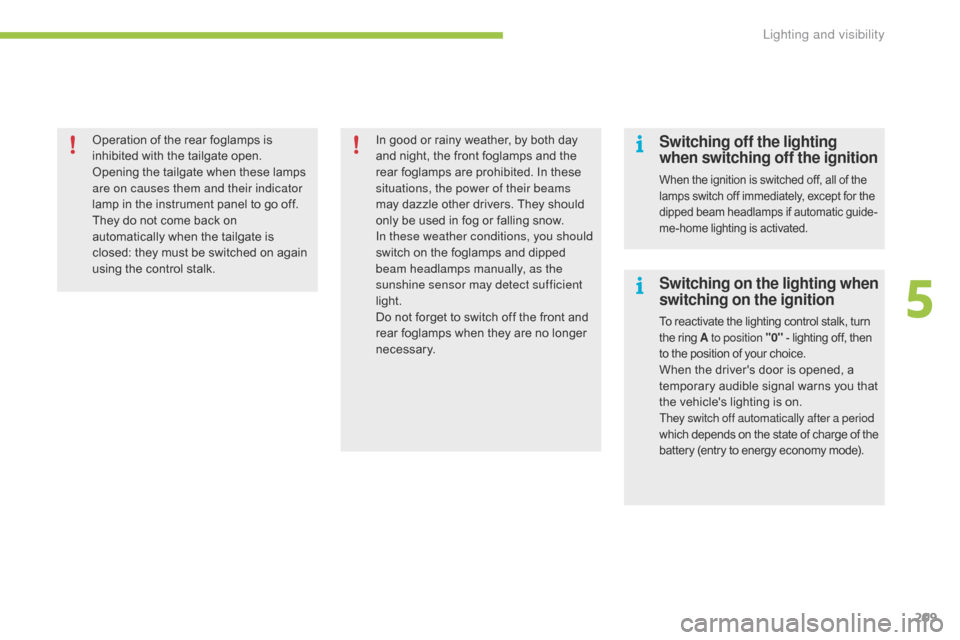
209
C4-Picasso-II_en_Chap05_eclairage-visibilite_ed01-2016
Operation of the rear foglamps is inhibited with the tailgate open.
Opening
the tailgate when these lamps
a
re on causes them and their indicator
lamp
in the instrument panel to go off.
They
do not come back on
a
utomatically when the tailgate is
c
losed: they must be switched on again
u
sing the control stalk. In
good or rainy weather, by both day a
nd night, the front foglamps and the
r
ear foglamps are prohibited. In these
s
ituations, the power of their beams
may
dazzle other drivers. They should
o
nly be used in fog or falling snow.
In these weather conditions, you should
switch
on the foglamps and dipped
b
eam headlamps manually, as the
sunshine sensor may detect sufficient
light.
Do
not forget to switch off the front and
r
ear foglamps when they are no longer
n
ecessary.Switching off the lighting
when switching off the ignition
When the ignition is switched off, all of the lamps switch off immediately, except for the d
ipped beam headlamps if automatic guide-
me-home
lighting is activated.
Switching on the lighting when
switching on the ignition
To reactivate the lighting control stalk, turn the ring A to position "0"
- lighting off, then t
o the position of your choice.
When the driver's door is opened, a temporary audible signal warns you that
t
he vehicle's lighting is on.
They switch off automatically after a period
which depends on the state of charge of the b
attery (entry to energy economy mode).
5
Lighting and visibility
Page 213 of 527
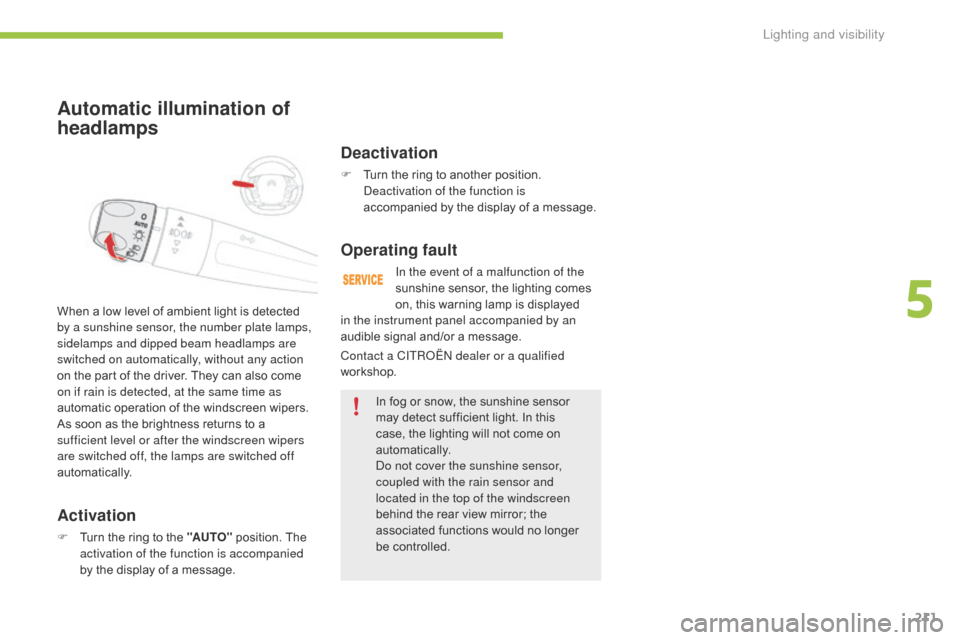
211
C4-Picasso-II_en_Chap05_eclairage-visibilite_ed01-2016
Automatic illumination of
headlamps
Activation
F Turn the ring to the "AUTO" position. The a
ctivation of the function is accompanied
by
the display of a message.
When
a low level of ambient light is detected
b
y a sunshine sensor, the number plate lamps,
sidelamps and dipped beam headlamps are
switched on automatically, without any action
on the part of the driver. They can also come
o
n if rain is detected, at the same time as
automatic operation of the windscreen wipers.
As soon as the brightness returns to a
s
ufficient level or after the windscreen wipers
are switched off, the lamps are switched off
automatically.
Deactivation
F Turn the ring to another position. D
eactivation of the function is
accompanied
by the display of a message.
Operating fault
In the event of a malfunction of the
sunshine sensor, the lighting comes
o
n, this warning lamp is displayed
I
n
fog or snow, the sunshine sensor
m
ay detect sufficient light. In this
c
ase, the lighting will not come on
au
tomatically.
Do not cover the sunshine sensor,
coupled with the rain sensor and
located in the top of the windscreen
behind
the rear view mirror; the
a
ssociated functions would no longer
be c
ontrolled.
Contact a CITROËN dealer or a qualified
workshop. in the instrument panel accompanied by an
audible
signal and/or a message.
5
Lighting and visibility
Page 218 of 527

216
C4-Picasso-II_en_Chap05_eclairage-visibilite_ed01-2016
Cornering lighting
This system, if fitted to your vehicle, makes use of the beam from a front foglamp to
i
lluminate the inside of a bend, when the
main or dipped beam headlamps are on and
the
vehicle speed is below 25 mph (40 km/h)
(
urban driving, winding road, junctions, parking
m
anoeuvres...). with cornering lighting
without cornering lighting
Switching on
This system starts:
- w hen the corresponding direction indicator
i
s switched on,
or
-
f
rom a certain angle of rotation of the
s
teering
w
heel.
Switching off
The system does not operate:
- b elow a certain angle of rotation of the
s
teering
w
heel,
-
a
bove 25 mph (40 km/h),
-
w
hen reverse gear is engaged.
The
cornering lighting can be activated or
d
eactivated in the Driving
menu.
F
Sel
ect the " Settings " tab, then " Lighting"
and " Directional headlamps ".
Lighting and visibility